Images: Bizarre, Primordial Sea Creatures Dominated the Ediacaran Era
During the Ediacaran period, about 635 million to 541 million years ago, oxygen was sparse, the oceans were murky and marine organisms ate by absorbing nutrients floating around in the water.
It was a very different world, according to fossils left behind by the soft-bodied life-forms that dominated the era.
"The Ediacaran period is the first time in Earth's history where you don't need a microscope to look at the fossils," said Marc Laflamme, an assistant professor of Earth science at the University of Toronto Mississauga. "This is the first time that life is big enough that you can look at it with the naked eye." [See Photos of These Life-Forms Discovered in Newfoundland, Canada]
Here's a look at the wacky organisms that called Earth home at the time:
Bizarre creature

During the Ediacaran — a period named for South Australia's fossil-rich Ediacara Hills — animals weren't the major players.
"There are some animals there, but they're not dominating the system like we have in the modern world," Laflamme told Live Science. "Animals churn up sediment, they burrow, they dig" — without them, the seafloor was likely incredibly firm and covered with thick bacterial mats, he said.
Sign up for the Live Science daily newsletter now
Get the world’s most fascinating discoveries delivered straight to your inbox.
However, researchers have found a few exceptions. For instance, this seafloor-dwelling tapewormlike animal, named Plexus ricei, dates to the Ediacaran period. The tubular critter measured about 5 to 80 centimeters (2 to 31 inches) long and 5 to 20 millimeters (0.2 inches to 0.8 inches) wide.
"Plexus was unlike any other fossil that we know from the Precambrian," study researcher Mary Droser, a paleobiologist at the University of California, Riverside, said in a statement. (Image credit: Credit: Droser Lab | UC Riverside)
Different roots
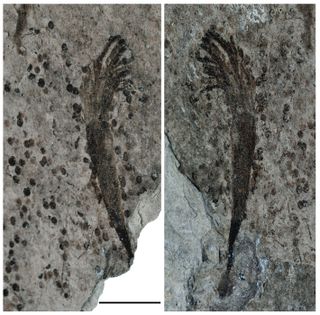
A plethora of bacteria probably covered the seafloor like a leathery carpet, Laflamme said. Likewise, many of the organisms that lived during that time didn't have root systems like today's plantsdo but instead had bottoms that were either disc- or ball-shaped (depending on whether they were inflated — it's hard to tell by looking at the fossils), Laflamme said.
The two seaweedlike fossils, pictured here, are small — about 2 inches (5 cm) long. It's unclear if they are plants or animals, as the bulbous structure at the bottom of their stalk could serve as an anchor for a plant. Or, it could be a proboscis, a tubelike feeding structure, of a wormlike creature, Live Science reported. (Image credit: Zhe Chen)
Rangeomorphs
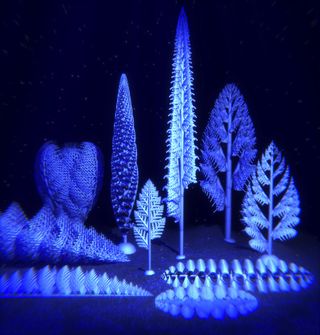
Other Ediacaran organisms, called rangeomorphs, had these disc-shaped root systems.
"It makes sense if they're living on a firm, rigid substrate," Laflamme said. "They don't dig roots into [the ground]; they just lie flat on it. Or, they burrow within, and this microbial mat that grew around it and held it in place."
Rangeomorphs were bizarre, fractal creatures with self-similar patterns found from the smallest to the largest scale of the organisms, Live Science reported in 2014. (Image credit: Jennifer Hoyal Cuthill | University of Cambridge)
Next generation

Some rangeomorphs displayed complex procreation. For instance, the soft-bodied rangeomorph known as Fractofusus (shown here) likely reproduced much like a strawberry plant does today, according to a study published Aug. 3, 2015, in the journal Nature. (Image credit: C. G. Kenchington)
Baby rangeomorph
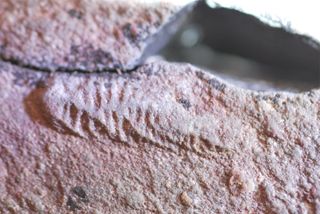
Researchers have even found juvenile rangeomorphs, including this 0.7-inch-long (17 millimeters) one shown here; the juvenile specimen was found at Mistaken Point Ecological Reserve in Newfoundland, Canada. Notice the detail on its branches. (Image credit: OU | Jack Matthews)
Suspension feeder
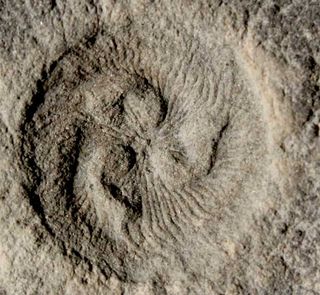
Tribrachidium, a bizarre sea creature that lived some 550 million years ago, is unlike any modern organism. It has three-fold symmetry — a feature that no living thing today has, Live Science reported in November. New research suggests that the creature fed on particles suspended in the water. (Image Credit: M. Laflamme)
Muscle maniac

Haootia quadriformis, the first known life-form to have muscles, lived during the late Ediacaran, about 560 million years ago. The creature's body looks like a circular disc, which it likely used to anchor itself to the seafloor.
The disc is connected by a short stalk to a sheetlike body made of fibrous bundles — believed to be muscles — arranged in a four-fold symmetry, Live Science reported in 2014. (Image credit: Credit: Martin Brasier)
Newfoundland fossils
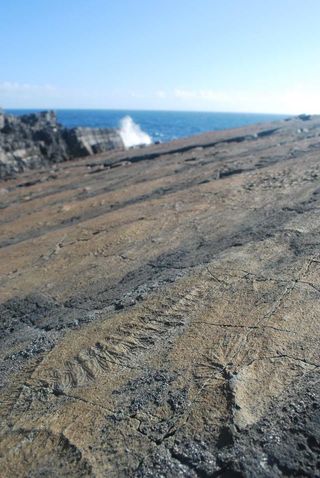
The Ediacaran had low levels of oxygen — likely one to two orders of magnitude lower than oxygen levels on today's Earth, Laflamme said. However, as marine animals evolved into filter feeders, they started eating the bacteria and nutrients in the murky water. The resulting clear water would have allowed sunlight to deliver energy to photosynthesizing bacteria, which, in turn, would have made more oxygen.
Once oxygen levels increased, animals thrived, and larger predators entered the environment. These animals tunneled and tore at the ocean floor, bringing an end to the rangeomorphs and other organisms, Laflamme said. ( Image Credit: OU | Jack Matthews)
Oldest animal skeleton
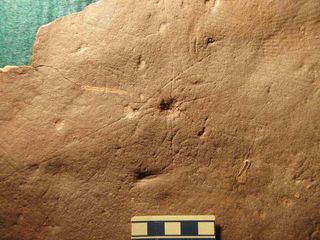
Pictured here is Coronacollina acula, an organism with a round center and four needlelike "spicules" that point outward. C. acula lived between 550 million and 560 million years, and is thought to be the oldest animal with a skeleton on record. It likely survived by filtering food from the water, experts told Live Science. (Image Credit: James Gehling)
Follow Laura Geggel on Twitter @LauraGeggel. Follow Live Science @livescience, Facebook & Google+.

Laura is the archaeology and Life's Little Mysteries editor at Live Science. She also reports on general science, including paleontology. Her work has appeared in The New York Times, Scholastic, Popular Science and Spectrum, a site on autism research. She has won multiple awards from the Society of Professional Journalists and the Washington Newspaper Publishers Association for her reporting at a weekly newspaper near Seattle. Laura holds a bachelor's degree in English literature and psychology from Washington University in St. Louis and a master's degree in science writing from NYU.
Most Popular

